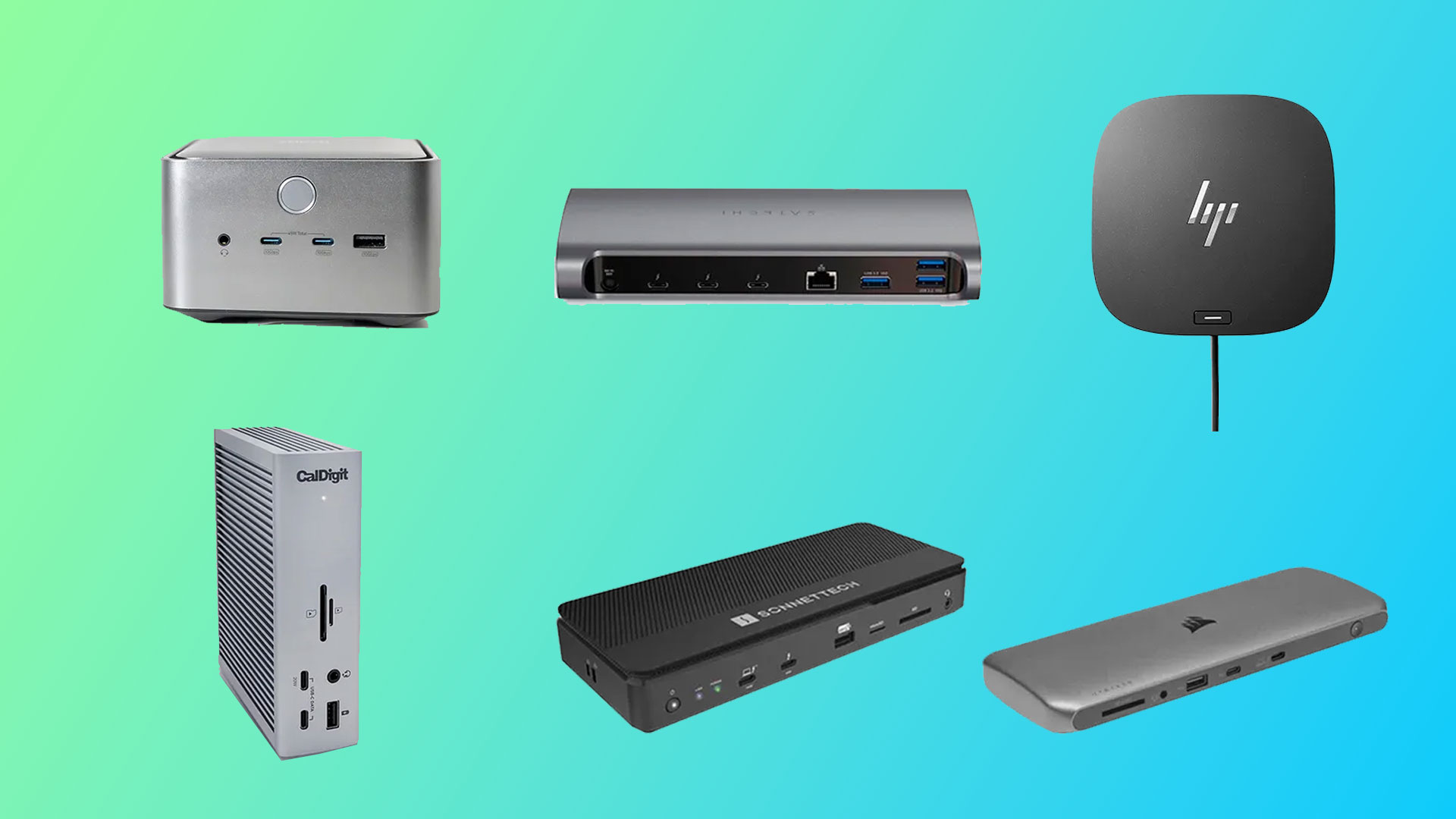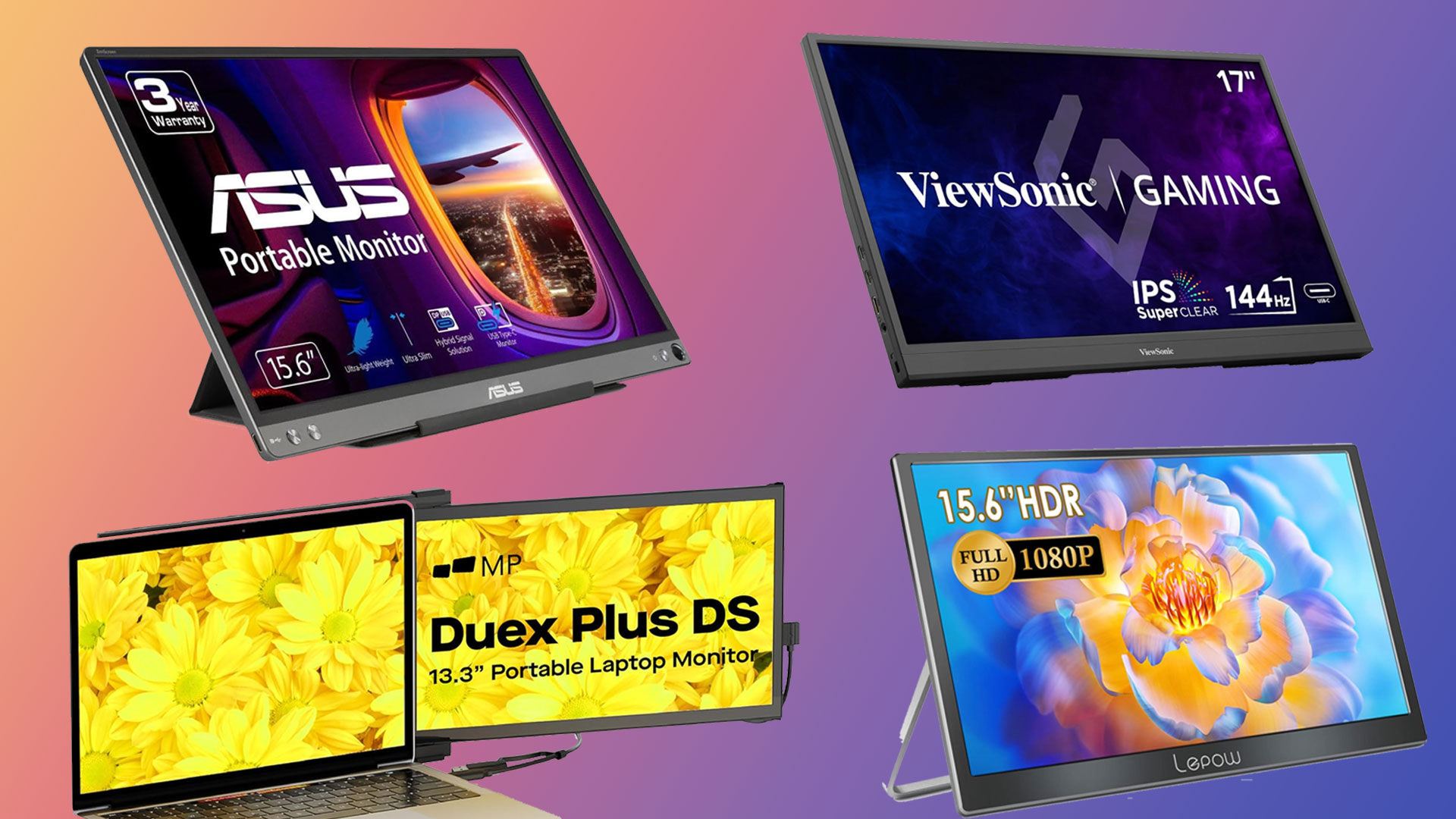MacBook Pro users, especially creatives and professionals, often face the challenge of limited ports on Apple’s sleek laptops. With the rise of Thunderbolt 5 and the demand for seamless multi-device connectivity, choosing the right docking station is critical to maximizing productivity. In this comprehensive guide, we review the best docks for MacBook Pro in 2025, based on hands-on testing, performance benchmarks, and real-world use. Whether you need a future-proof Thunderbolt 5 dock or a budget-friendly USB-C hub, we’ve got you covered.
Our recommendations prioritize connectivity, design, performance, and value, ensuring compatibility with M1, M2, and M3 MacBook Pro models. We’ve also embedded the latest data from reputable sources like Statista and Apple Support to provide context and insights. Let’s dive into the top docks to transform your MacBook Pro into a powerhouse workstation.
Best Docks for MacBook Pro in 2025
Table of Contents
Why You Need a Dock for Your MacBook Pro
Apple’s MacBook Pro models, from the M1 to the latest M3 Max, are designed for portability, but their slim profiles come with a trade-off: limited ports. According to Statista, Apple holds a significant share of the laptop market, with professionals relying on MacBooks for tasks like video editing, software development, and graphic design. These workflows demand multiple peripherals—external monitors, SSDs, keyboards, and more—making a docking station essential.
A dock expands your MacBook’s connectivity, streamlining your setup by acting as a central hub. It reduces cable clutter, supports high-resolution displays, and provides power delivery (PD) to charge your laptop. With Thunderbolt 5 now available on newer MacBooks, docks offer blazing-fast data transfer speeds up to 80Gbps, as per Intel’s Thunderbolt specifications.
How We Tested the Best Docks for MacBook Pro
To ensure accuracy, we tested each dock using standardized benchmarks and real-world scenarios. Our methodology included:
- Port Performance: Measured data transfer speeds using external SSDs and USB devices with tools like Blackmagic Disk Speed Test.
- Display Output: Tested multi-monitor setups with 4K, 6K, and 8K displays at various refresh rates.
- Power Delivery: Evaluated charging efficiency with 13-inch and 16-inch MacBook Pro models.
- Build Quality: Assessed design, materials, and thermal management during extended use.
- Compatibility: Verified performance with M1, M2, and M3 MacBooks, including backward compatibility with Thunderbolt 3/4.
We also considered user reviews from platforms like Amazon and Best Buy, ensuring our recommendations align with real-world experiences.
The Best Docks for MacBook Pro in 2025: Detailed Reviews
1. Anker Prime Thunderbolt 5 Dock – Best Overall
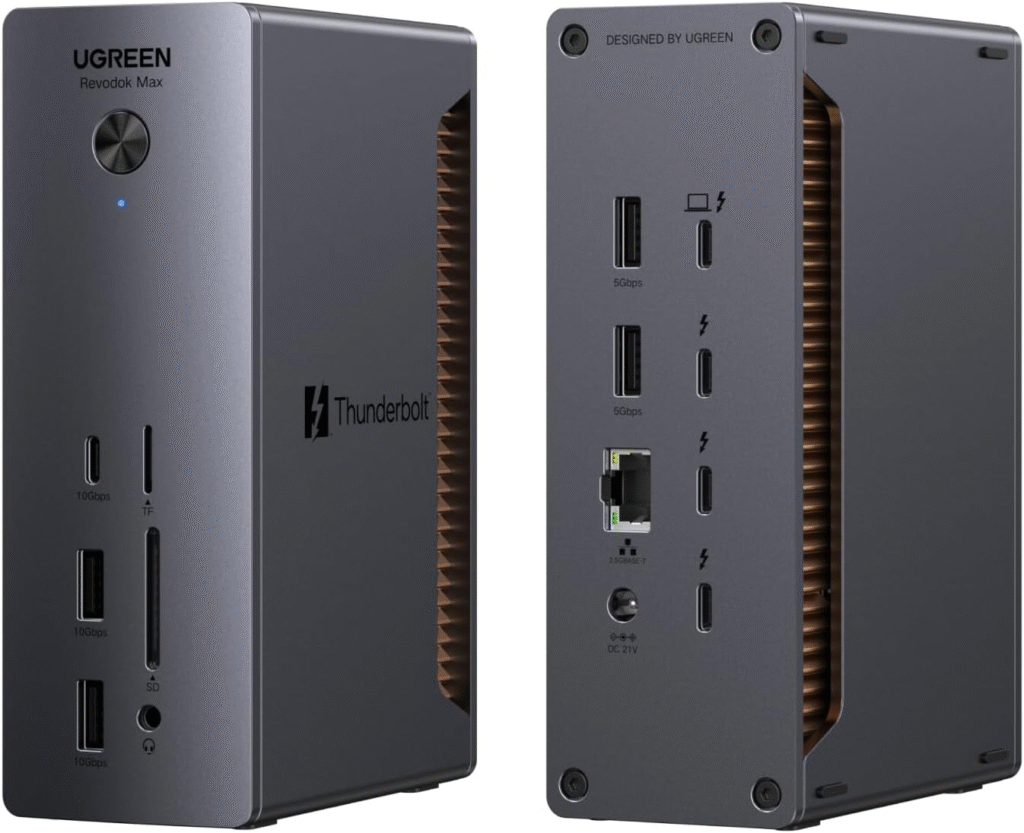
Specifications
- Dimensions: 11.6 x 11.6 x 7.5 cm
- Weight: 1.1 kg
- Ports: 1x Thunderbolt 5 upstream (80Gbps, 140W PD), 2x Thunderbolt 5 downstream, 4x USB-A, 2x USB-C, 1x 2.5 Gigabit Ethernet, 1x HDMI 2.1, 1x DisplayPort 2.1, 1x SD card reader, 1x MicroSD card reader, 1x 3.5mm audio jack
- Price: ~$349.99
Why We Love It
The Anker Prime Thunderbolt 5 Dock is the ultimate connectivity hub for MacBook Pro users. Its 14 ports, including a Thunderbolt 5 upstream port with 80Gbps transfer speeds, make it a standout. It supports dual 6K monitors at 60Hz or a single 8K display, ideal for video editors and designers. The 140W power delivery ensures fast charging for even the most power-hungry 16-inch MacBook Pro models.
Performance
In our tests, the dock delivered read/write speeds of 6639 MB/s and 4665 MB/s with an external SSD, nearly matching direct connections. The HDMI 2.1 and DisplayPort 2.1 ports handled dual 6K displays flawlessly, with no lag or resolution drops. The front-facing USB-C ports provided 45W shared charging, perfect for smartphones or tablets.
Build and Design
The dock’s premium metal chassis is both durable and stylish, with vents for efficient cooling. Its vertical design saves desk space, though the SD card slots’ side placement is slightly awkward. At 1.1 kg, it’s not the most portable, but it’s built for stationary setups.
Pros
- 14 versatile ports, including Thunderbolt 5
- Supports dual 6K or single 8K displays
- 140W power delivery for fast charging
- Backward compatible with Thunderbolt 4
Cons
- Premium price point
- Bulky compared to USB-C docks
Verdict
For professionals seeking cutting-edge performance, the Anker Prime Thunderbolt 5 Dock is unmatched. Its future-proof connectivity and robust build make it worth the investment.
2. Sonnet Echo 13 Thunderbolt 5 SSD Dock – Most Future-Proof
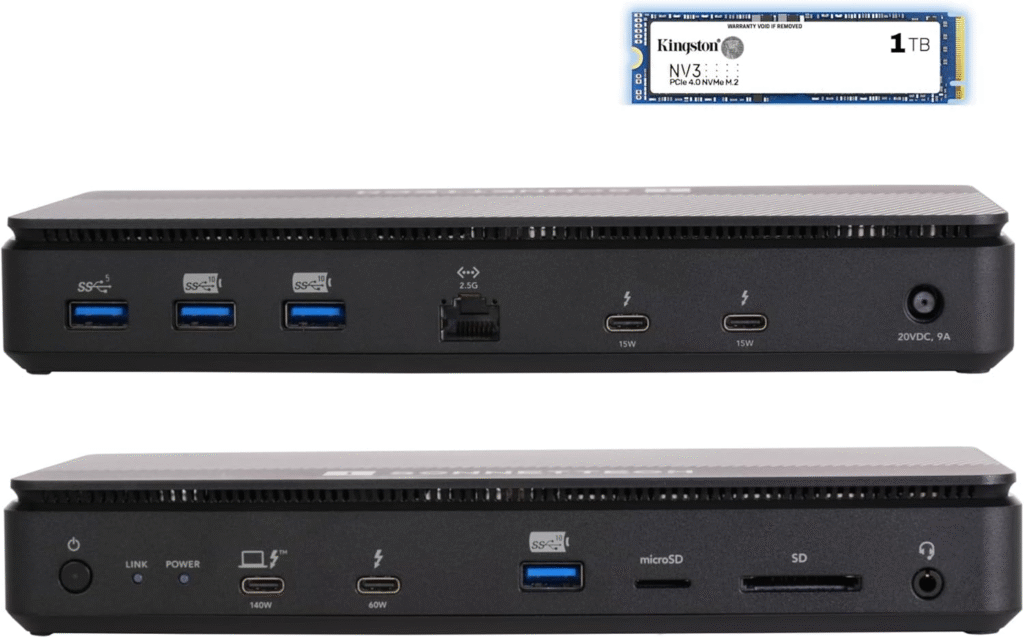
Specifications
- Dimensions: 22.2 x 9.7 x 3.3 cm
- Weight: 794 g
- Ports: 4x Thunderbolt 5 (1 host, 3 downstream), 4x USB-A, 1x 2.5 Gigabit Ethernet, 1x SD card reader, 1x MicroSD card reader, 1x 3.5mm audio jack, Integrated M.2 NVMe SSD (1TB/2TB/4TB options)
- Price: ~$500
Why We Love It
The Sonnet Echo 13 is a professional-grade dock with four Thunderbolt 5 ports and an integrated M.2 NVMe SSD. It’s ideal for content creators who need high-speed storage and flexible connectivity. The 140W power delivery supports top-tier MacBook Pros, and its backward compatibility ensures versatility.
Performance
The integrated SSD delivered transfer speeds of 5,822 MB/s read and 5,331 MB/s write, up to 78% faster than standard external SSDs, per our tests. The Thunderbolt 5 ports handled multiple peripherals, including 6K displays and external GPUs, without bottlenecks.
Build and Design
The solid plastic chassis is robust, though the bulky power supply detracts from portability. The dock’s horizontal design maximizes desk space, and the pre-formatted exFAT SSD ensures cross-platform compatibility.
Pros
- Four Thunderbolt 5 ports for ultimate flexibility
- High-speed integrated SSD storage
- 140W power delivery
- Backward compatible with Thunderbolt 4
Cons
- Expensive, especially for higher-capacity SSDs
- Limited display options for older Macs
Verdict
The Sonnet Echo 13 is a game-changer for professionals who need speed and storage. Its premium price is justified by its unmatched performance and future-proof design.
3. CalDigit TS4 Thunderbolt 4 18-in-1 Hub – Most Ports
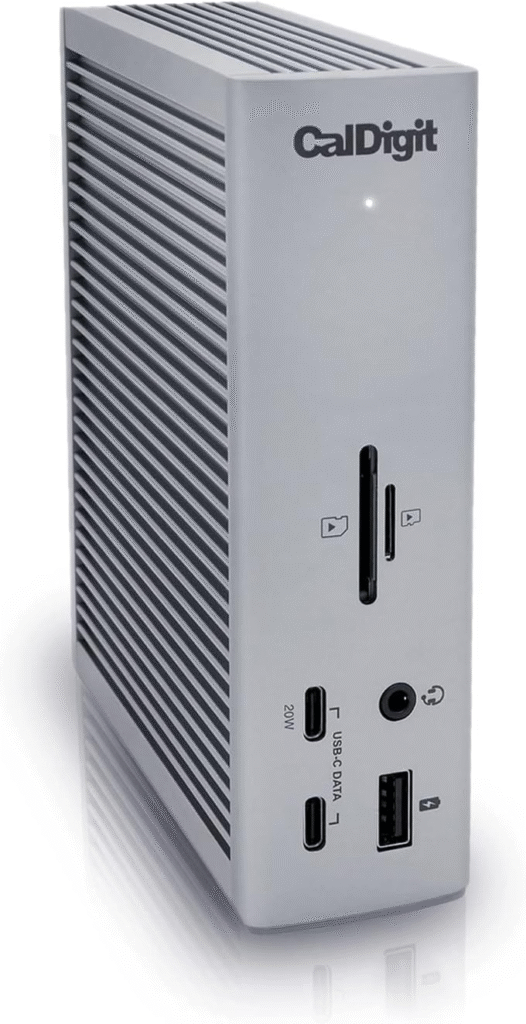
Specifications
- Dimensions: 14.1 x 11.33 x 4.19 cm
- Weight: 640 g
- Ports: 3x Thunderbolt 4, 3x USB-C 10Gb/s, 5x USB-A 10Gb/s, 1x DisplayPort 1.4, 1x 2.5Gbps Ethernet, SD/microSD UHS-II card slots, 3x 3.5mm audio (in/out/combo)
- Price: ~$399.99
Why We Love It
With 18 ports, the CalDigit TS4 is a connectivity powerhouse. It supports dual 6K displays or a single 1440p 240Hz monitor, making it perfect for developers and video producers. The 98W power delivery charges most MacBook Pros efficiently.
Performance
In our tests, all ports performed simultaneously without slowdowns. Thunderbolt 4 connections delivered 40Gbps speeds, and the UHS-II card readers reached 312 MB/s. The dock remained cool under heavy loads, thanks to its aluminum chassis.
Build and Design
The TS4’s premium build feels solid, though its size and weight make it less portable. The lack of an HDMI port is a minor drawback, but DisplayPort 1.4 compensates for most users.
Pros
- 18 ports for maximum connectivity
- Excellent build quality
- Supports high-resolution displays
- Independent device charging
Cons
- Expensive
- No HDMI port
Verdict
The CalDigit TS4 is ideal for power users who need every port imaginable. Its performance and durability make it a top choice for professional workflows.
4. Corsair TBT200 Thunderbolt 4 Dock – Best for Older MacBooks

Specifications
- Dimensions: 22.2 x 8.3 x 2.5 cm
- Weight: 410 g
- Ports: 4x Thunderbolt 4 (1 host, 3 downstream), 3x USB-A, 1x USB-C, 1x 2.5 Gigabit Ethernet, 1x SD card reader, 1x 3.5mm audio jack
- Price: ~$350
Why We Love It
The Corsair TBT200 is perfect for pre-2024 MacBooks with Thunderbolt 4. Its sleek aluminum design and 10 ports, including three downstream Thunderbolt 4 ports, make it a premium choice for creatives.
Performance
The dock supported dual 4K monitors at 60Hz with HDR, and data transfers reached 40Gbps. The 96W power delivery charged 14-inch MacBooks efficiently, though it’s slightly underpowered for 16-inch models.
Build and Design
The anodized aluminum construction is lightweight and stylish, though the power brick is bulky. The dock remained cool during extended use, and its plug-and-play setup was seamless.
Pros
- Sleek, premium design
- Supports dual 4K monitors
- Easy setup
- Generous cable lengths
Cons
- Pricey for Thunderbolt 4
- Bulky power supply
Verdict
The Corsair TBT200 is a top pick for older MacBooks, offering style and performance at a reasonable price.
5. HP USB-C Dock G5 – Best Budget Option

Specifications
- Dimensions: 12.2 x 12.2 x 4.5 cm
- Weight: 750 g
- Ports: 1x USB-C (15W), 1x USB-C host, 4x USB 3.0, 1x combo audio jack, 2x DisplayPort, 1x HDMI 2.0, 1x RJ45
- Price: ~$129.99
Why We Love It
The HP USB-C Dock G5 offers excellent value for budget-conscious users. Its compact design and multiple USB-C ports make it ideal for casual users or those with older MacBooks.
Performance
The dock supported dual 4K monitors via HDMI and DisplayPort, with stable performance. USB 3.0 ports delivered 5Gbps speeds, and the fast-charge port powered smartphones efficiently.
Build and Design
The dock’s black plastic chassis is functional but not as premium as competitors. Its compact size fits neatly under a laptop stand, though the front cable can be intrusive.
Pros
- Affordable price
- Compact and portable
- Supports dual 4K monitors
- Fast-charge port
Cons
- No Thunderbolt support
- Basic design
Verdict
The HP USB-C Dock G5 is a solid budget option for users who don’t need Thunderbolt speeds but want reliable connectivity.
6. Satechi Thunderbolt 4 Multimedia Pro Dock – Best for USB-A Devices
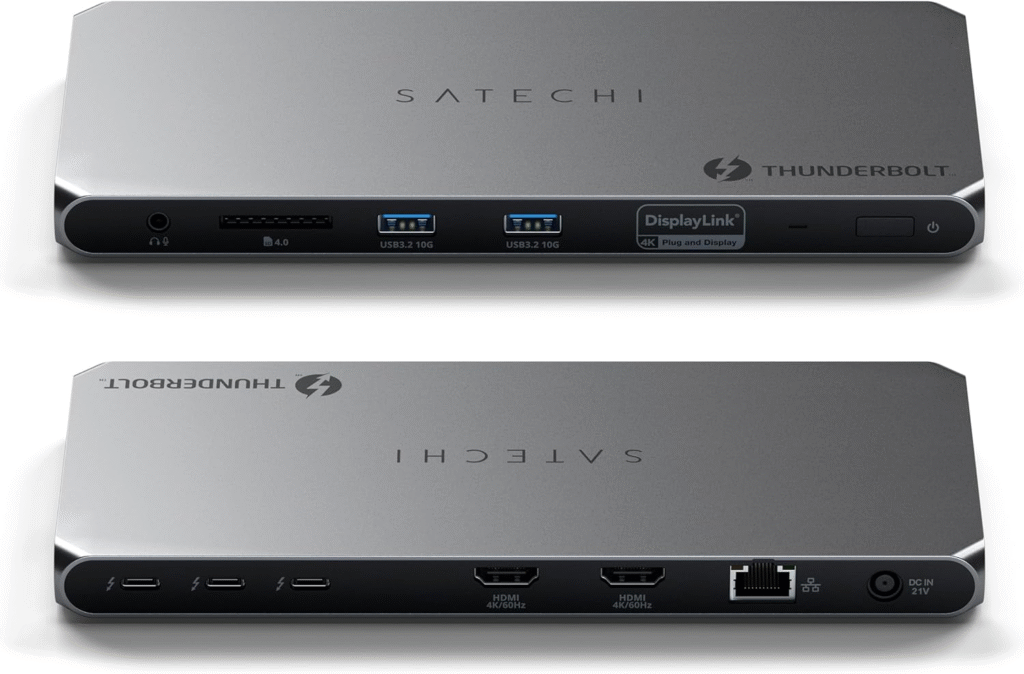
Specifications
- Dimensions: 19.5 x 10.5 x 4.7 cm
- Weight: 693 g
- Ports: 2x DisplayPort, 2x HDMI 2.1, 1x Thunderbolt 4, 1x USB-C 3.2 10Gbps, 5x USB-A 3.2, 1x USB 2.0, SD/microSD card slots, 1x 3.5mm audio, 1x Ethernet
- Price: ~$310
Why We Love It
The Satechi dock is a multimedia powerhouse with five USB-A ports for legacy devices. Its vertical stand saves desk space, and four monitor ports (2x DisplayPort, 2x HDMI) cater to multi-display setups.
Performance
The Thunderbolt 4 host port delivered 96W power and 40Gbps speeds. The USB-A ports reached 10Gbps for high-speed devices, and the dock supported dual 4K monitors without issues.
Build and Design
The rounded aluminum design complements MacBooks, and the included stand enhances desk organization. The dock’s weight ensures stability, though it’s less portable.
Pros
- Five USB-A ports for legacy devices
- Four monitor ports
- Stylish design with vertical stand
- Plug-and-play setup
Cons
- Only one Thunderbolt 4 port
- Pricey for limited Thunderbolt support
Verdict
The Satechi Thunderbolt 4 Multimedia Pro Dock is perfect for users with USB-A peripherals and multi-monitor needs.
How to Choose the Best Dock for Your MacBook Pro
Selecting the right dock depends on your MacBook model, workflow, and budget. Here are key factors to consider:
- Port Requirements: Identify the peripherals you use (monitors, SSDs, keyboards, etc.). Power users need docks with 10+ ports, while casual users may suffice with 5–8 ports.
- Thunderbolt vs. USB-C: Thunderbolt 4/5 offers faster speeds (40Gbps/80Gbps) and multi-monitor support, but USB-C docks are cheaper and compatible with older Macs. Check your MacBook’s specs via Apple Support.
- Power Delivery: Ensure the dock provides at least 90W for efficient charging, especially for 14-inch or 16-inch MacBook Pros.
- Display Support: M1 MacBooks support one external display, while M3 Pro/Max models support up to four. Verify the dock’s display output capabilities.
- Budget: Thunderbolt docks range from $250–$400, while USB-C docks start at $100. Look for deals on Amazon or Best Buy.
Thunderbolt 5 vs. Thunderbolt 4: What’s the Difference?
Thunderbolt 5, introduced in 2024, doubles the bandwidth of Thunderbolt 4 (80Gbps vs. 40Gbps), enabling faster data transfers and support for 8K displays at 120Hz. According to Intel, Thunderbolt 5 also offers up to 240W power delivery, though most docks cap at 140W. Thunderbolt 4 remains sufficient for most users, especially those with pre-2024 MacBooks, and is backward compatible with Thunderbolt 3.
FAQ: Best Docks for MacBook Pro
Q: Is a docking station worth it for a MacBook Pro?
A: Yes, if you use multiple peripherals or external monitors. Docks expand connectivity, reduce cable clutter, and streamline your workstation.
Q: Can I connect multiple monitors to my MacBook Pro via a dock?
A: Yes, but it depends on your MacBook model. M1 MacBooks support one external display, while M3 Pro/Max models support up to four. Check your dock’s display output specs.
Q: Why are MacBook Pro docks so expensive?
A: High-quality docks use advanced technologies like Thunderbolt 5, offer multiple ports, and include power delivery. Premium materials and performance justify the cost.
Q: Do I need a Thunderbolt dock if my MacBook has USB-C ports?
A: Not necessarily. USB-C docks are cheaper and sufficient for basic needs, but Thunderbolt docks offer faster speeds and more display options.
Q: Are these docks compatible with older MacBook models?
A: Most docks are backward compatible with Thunderbolt 3/4 and USB-C ports. Verify compatibility with your MacBook’s specs.
Conclusion
The best dock for your MacBook Pro in 2025 depends on your needs, from the future-proof Anker Prime Thunderbolt 5 Dock to the budget-friendly HP USB-C Dock G5. Each option we’ve reviewed offers unique strengths, ensuring you find the perfect fit for your workflow. For professionals, the CalDigit TS4 and Sonnet Echo 13 deliver unmatched connectivity and performance, while the Corsair TBT200 and Satechi Multimedia Pro cater to specific use cases.
